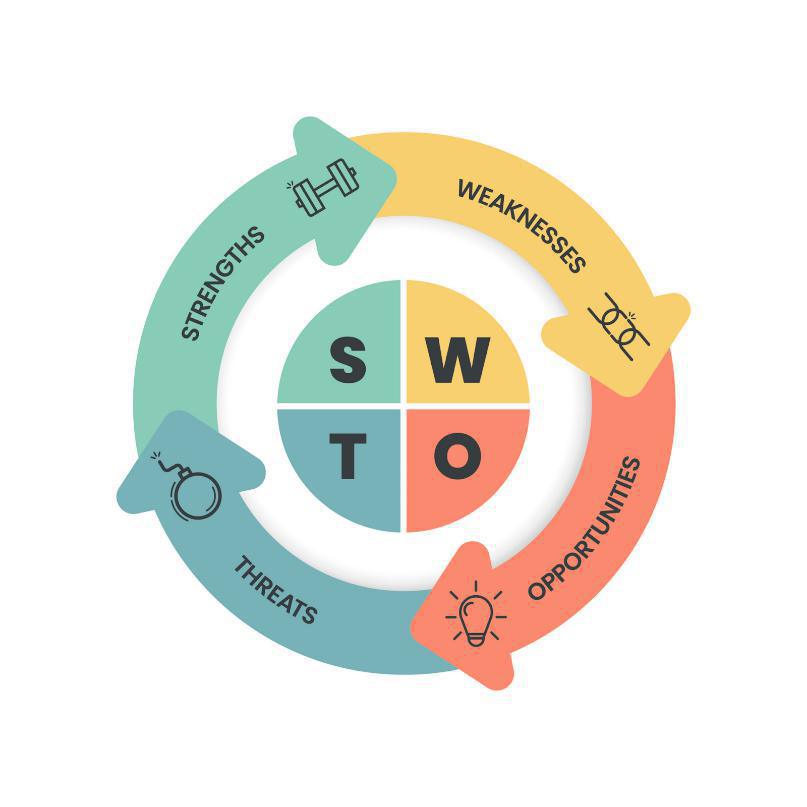Overwiev
SWOT Analysis, an acronym for Strengths, Weaknesses, Opportunities, and Threats was first introduced in the 1960s as a strategic planning tool by Albert Humprey and his team at the Stanford Research Institute. Since then, SWOT Analysis has been a cornerstone of strategic management.
Being a versatile tool with applications spanning across industries and functions, organizations generally use SWOT Analysis in:
1. Strategic Management: Forming the foundation of effective strategic management, SWOT Analysis helps organizations in assessing their internal capabilities and external environment, allowing for informed decision-making.
2. Corporate Development: This method of understanding the dynamic business environment, assists in identifying synergies and risks while evaluating potential mergers acquisitions, or dangers.
3. Corporate Planning: SWOT guides the formulation of corporate plans by highlighting areas that require attention and investment.
4. Targeting Options: Moreover, SWOT also helps in pinpointing the most promising opportunities and devising strategies to seize them for the marketing and sales department.
Mode of Operation
The entire idea of SWOT is to understand the changing and dynamic corporate environment involving a structured assessment of internal and external factors.
1. Strengths: This includes internal factors like core competencies, unique resources, and positive attributes.
2. Weaknesses: This includes pinpointing Internal Limitations, Areas of improvement, and potential vulnerabilities.
3. Opportunities: Executives assess external factors such as market trends, consumer preferences, and technological advancements for growth prospects.
4. Threats: External challenges, competitive forces, and potential risks that could hinder the success are analysed.
Features
1. Simplicity: SWOT is easy to understand and apply; making it accessible to all levels of management.
2. Comprehensive: It offers a holistic view of an organization's situation by considering internal and external factors.
3. Flexibility: SWOT Analysis can be tailored to suit specific objectives, whether it’s for a single project or long-term corporate planning.
4. Visual Representation: Many organizations use traces or diagrams to present SWOT findings, enhancing clarity and communication.
Advantages
1. Informed Decision Making: SWOT equips executives with valuable insights, aiding in well-informed and strategic decision-making.
2. Alignment: It helps align the entire organization towards common goals by highlighting strengths to leverage and weaknesses to mitigate.
3. Risk Mitigation: By identifying threats in advance, companies can proactively develop contingency plans.
4. Cost Effective: SWOT doesn’t require extensive resources or investment, making it accessible to businesses of all sizes.
Disadvantages
1. Simplistic: Some argue that SWOT oversimplifies complex issues, potentially missing nuances.
2. Subjective: SWOT Analysis can be influenced by individual biases and perceptions, leading to inaccurate assessments.
3. Static: It provides a snapshot of the current situation and may not adapt well to rapidly changing environments.
4. Lack of Prioritization: While it identifies factors, it doesn’t inherently prioritize them, leaving executives to determine which aspects to focus on.
Conclusion
The SWOT analysis is a powerful tool in strategic management, corporate development, and planning. The tool’s simplicity, comprehensiveness, and versatility make it an invaluable asset for entrepreneurs and C-level executives seeking to navigate the complex landscape of strategic decision-making.
When used judiciously, SWOT Analysis can illuminate the path to success by leveraging strengths, addressing weaknesses, seizing opportunities, and mitigating threats, ultimately driving strategic excellence in any organization.


